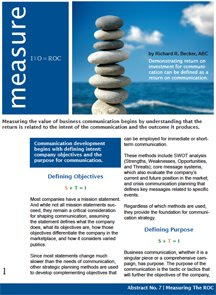
Last November, Motrin came under fire for a snarky advertisement that played on the idea that moms who use baby carriers and slings are making a fashion statement that "totally makes me look like an official mom." After Motrin pulled the advertisement to avoid more outcry, there was plenty of debate whether or not the ad should have been pulled.
Unfortunately, many debaters asked the wrong question. Most asked a broader audience whether or not the advertisement was offensive or if the outcry was an overreaction. No surprise, most men, single women, moms who don't use baby carriers/slings, etc. all said that moms who do carry their babies in slings overreacted, which mirrored a USA Today poll that revealed only about 31 percent of the public said that the ad went too far.
"See?" said some. "Most people were not offended."
Except, except, except, communication is not an election where companies can afford a 51 percent approval rating for the win. It didn't matter what most men, single women, moms who don't use baby carriers/slings thought of the advertisement. It only mattered what moms who do carry their babies in slings thought because they were the intended audience. Specifically, the offending advertisement had nothing to do a print campaign as USA Today reported. It had to do with one video popping up on a site that consisted of moms who do carry their babies in slings. They were the audience!
How do you realize intent in communication?
Once you have the right message, your best bet is to make it suitable for the organization, medium, and audience. This is the portion of the ROC equation where execution matters most. The right message produced the wrong way could have disastrous results.
Organizational Suitability
In 2007, Gap, Apple, Motorola, and others spent nearly $100 million on the Red campaign that raised only $18 million, drawing concern among nonprofit watchdogs, cause-marketing experts, and even executives in the ad business. The controversy was a painful reminder that cause marketing is better suited to campaigns that are a little less slick and whole lot less expensive.
But it doesn't end with nonprofits. Draft FCB locked in its loss of the Wal-Mart account after rubbing the win in the face of its peers. A single photo set the tone for the downfall of a presidential candidate. PETA seemed to struggle with the concept. YouTube even requires you confirm you are over the age of 18 to view the ad.
Medium Suitability
This is the reason that Bud.tv is dead. As a video and entertainment site in which the brewer infused millions of dollars to produce, the concept was right but the message as well as the execution for the medium was all wrong. And now, it's closed. It might have worked, but they forgot to focus on what they know. Um, beer.
Medium suitability is also why marketing-laced press releases don't go anywhere. In 2005, for example, Pole Position Marketing apologized for sending out a release that it later described as "less than substantial" and "lacked additional relevant information." At least they had the good sense to apologize. The release was better suited for a company blog. Um, on second thought, that one didn't even warrant a post.
There is an entire Web site dedicated to bad billboards. Esquire featured several bad television commercials. Someone posted a great example of a bad radio commercial on YouTube. Almost all of them have one thing in common. They are not suited for the medium.
Audience Suitability
When Miller beer attempted to target microbrew beer drinkers a few years ago, not only did non-customers NOT buy Miller, but the ads also alienated Miller’s core blue collar consumer. The agency won awards for the campaign, and Budweiser quickly captured the alienated Miller drinker. In sum, they gave up the girl all because of one Dick.
It made about as much sense as Chrysler giving up on its roots to spend more than $100 million on Dr. Z. Did they really expect to capture German car buyers while retaining the people who gave you a second shot because of this guy?
If you want to know who gets it right, consider McDonald's. They seem to understand this in Japan, Korea, Israel, and everywhere else. Same message, different audience.
Suitability Helps Connect
Social media isn't much different. When one of my students mentioned that my posts break some from the conventions I'm teaching them about news releases, I chuckled. Different mediums call for different presentations. I wouldn't put this post on a billboard either. Or in other words, in the right venue, the Motrin advertisement might have worked.
Download The Abstract: Measure: I | O = ROC
The ROC is an abstract method of measuring the value of business communication by recognizing that the return on communication — advertising, marketing, public relations, internal communication, and social media — is related to the intent of the communication and the outcome it produces. Every Monday, the ROC series explores portions of the abstract.






















